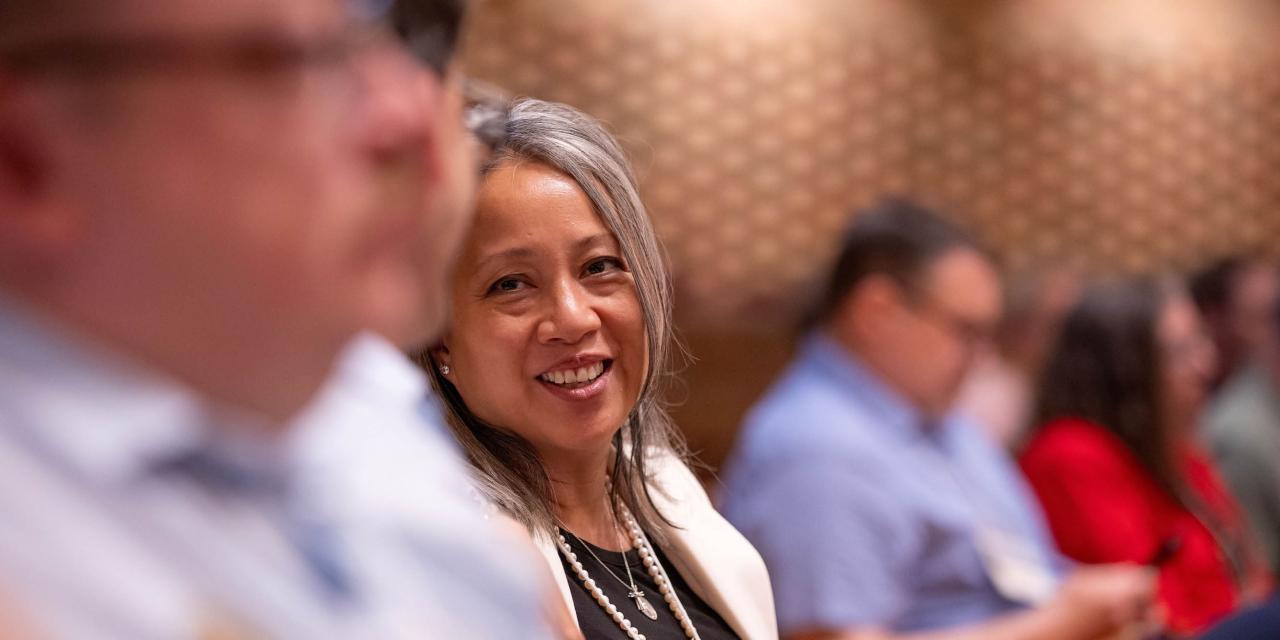Kate Strater teaches special education at Calvin University in Grand Rapids, Michigan. She also directs Calvin’s Life and Career Studies program, which offers post-secondary certificates for young adults with intellectual disability. She works to help the church deepen its embrace of children, adults, and families affected by intellectual and other disabilities. In this edited conversation, Kate Strater explains how churches can work with schools, agencies, and young adults with intellectual disability so that all can flourish.
Can you describe your work with young adults with intellectual disability?
I began my career in teaching and administration for students with intellectual disability (ID) and autistic students with ID in Colorado, Michigan, and Kentucky. Before coming to teach special education at Calvin University in Grand Rapids, Michigan, I headed up a Kentucky Project SEARCH site, a program that started at Cincinnati Children’s Hospital and expanded across the nation. Project SEARCH offers job internships where young adults with ID work alongside everyone else.
I got to know many young adults with ID who successfully transitioned to integrated employment and independence. Integrated employment means doing a job in the general public and earning competitive wages rather than receiving sub-minimal pay in a sheltered workplace where every worker has a disability.
Training through Project SEARCH’s Transition-to-Work program takes place entirely at job sites. I became interested in inclusive postsecondary education because young adults told me they wanted to experience living independently. Now, besides teaching students who intend to become special education teachers, I also direct Calvin University’s Life and Career Studies program.
What can churches learn from schools about including young adults with ID?
Faith formation may be rooted in gestures of the body, growing in the Spirit together, and teaching of biblical curricula. Churches can learn more about curriculum access and instruction from schools. Faith formation curricula (and perhaps preaching, for that matter) for all ages need to be accessible to contribute meaningfully to an individual’s spiritual growth. Church worship and education are often very heavy in written and spoken language. But if a curriculum or sermon cannot be read or understood, it creates separation. Churches can learn from inclusive educators to use plain-language summaries and add pictures and actions to written and spoken content.
Just as schools develop Individualized Education Plans (IEPs) for students with disability, churches can design responsive plans for people with ID and developmental disabilities. The key is getting to know each person as an individual with different strengths, gifts, dreams, and challenges. Then we put together a plan that maximizes participation in all church activities—on Sundays and between Sundays. It is impossible to put limits on inclusive postsecondary education or church ministry for a person with ID who desires to be part of a worship or learning community. Our goal as educators, service providers, and church members is to provide any needed learning, living, and social supports so that the individual can live into their goals and vision for what life should be like.
Can you say more about plain-language summaries in church?
Cognitive supports in a sermon would be helpful. When the sermon starts, the direction of the sermon is often a surprise. We are provided with a title and a scripture passage but very little signage to predict where the sermon will take us. Will we be going left or right? Will we be following a map? Providing an outline, a plain-language summary, and perhaps a visual representation of any difficult concepts would help with perceptibility.
Creating a plain-language summary of a written sermon or lesson is easy to do. You simply copy the text into ChatGPT or CoPilot, specify your desired word count, prompt the AI tool to “create a plain-language summary,” and the tool will do it for you. For creating visual representations, I used to use a program called Writing with Symbols. That has been replaced with Widgit Online, which offers a free trial, but its plans are expensive. So far, most picture symbols are copyrighted, so you need a license to use them. However, since 2011, The Noun Project has been developing a library of open-source icons and photos to build a global visual language, and it continues to get better and better. These icons, symbols, and pictures are free and easy to integrate within text.
What do churches miss out on by not including young adults and others with ID?
They miss out on the joy of truly knowing other members of the body of Christ. Communities thrive with good and right relationships. My life is richer with all the relationships I have, including people with ID or developmental disability. We miss an opportunity to flourish when we sustain barriers to knowing one other and growing together.
It has been a joy to know young adults, see what they want to do, and help them lay out a path to get there. I also love working with families and advocates to make sure that the people with ID are centered—which isn’t always a guarantee, even in disability advocacy organizations.
Can you say more about centering the individual with ID?
Over years of working alongside people with intellectual disability, I have learned to listen better and get out of the way. It is difficult to truly hear when institutions, agencies, and parents have agendas; figuring out how to listen to the individual has been a great area of growth and a blessing.
Whether they are children, teens, young adults, or older adults, people with ID may need different supports according to their stage of life and their individual abilities. But that doesn’t mean they should be denied the opportunity to serve as they feel gifted, whether in church choir, leading worship, leading prayer, teaching children, congregational hospitality, or another church ministry.
Can you share any insights from the 2024 CICW Summer Seminar?
I co-led the summer seminar Flourishing Together: Becoming an Accessible and Welcoming Church with Erik W. Carter from Baylor University in Waco, Texas. He is the executive director of the Baylor Center for Developmental Disabilities, which aims to promote the thriving of people with disabilities and their families. Erik Carter has researched five different ways that churches engage in disability ministry. His research shows that whether a person with ID really flourishes depends on whether their community does ministry apart, to, among, with, or with and by.
What an amazing week it was! Dr. Carter began our time together by sharing his research on accessible worship based on interviews with thirty-seven people with various disabilities. He articulated the postures taken by congregations committed to accessibility in all activities of ministry. Diving into the postures allowed congregational leaders to evaluate their own experiences: Where are we already strong and focused? What might we need to address next? What are our goals for further down the road?
What else did participants learn at the summer seminar?
We looked at the activities of ministry on Sundays and between Sundays. Victoria White and Rebecca Wall, both from With Ministries, helped us look carefully at universal and responsive worship design and friendship. We explored resources from Accessible Gospel, Inclusive Worship; Worship as One: Varied Abilities in the Body of Christ; and the Friendship With manual. I spent a day with our seminar participants looking at accessibility in faith formation curricula using technology and looking at ways to extend teaching beyond words.
Some of the most impactful parts of our six days together were experiencing examples of accessible and inclusive worship with Benjamin’s Hope (Holland, Michigan)and Calvary Church (Grand Rapids, Michigan) and hearing from Dr. Kevin Timpe about the history of disability rights and the advocacy role that churches must step into. During our Community Conversation, we heard from more than a hundred members of our community about what can be done to create a welcoming and accessible church. We did short- and long-term action planning. It was a productive and uplifting week of coming together, engaging in vision work, and planning our next steps toward building inclusive communities reflective of the beautiful and stunningly diverse kingdom of God.
What good first steps can churches take to better include, integrate, and appreciate people with ID or other disabilities?
Start with a vision for what an inclusive community should/could look like. Who is here? Who is missing? It can be so hard to imagine ourselves or others outside of the situation we’re currently in. Talk about the vision and help other church members to see it. Be intentional about talking with those who have disabilities to hear their insights and dreams. Choose one thing to work on and follow through together.
There are many aspects to church inclusion, including architecture, sacraments, preaching, and what happens at church during the week. Some churches take a very disciplined approach so that they step-by-step include all abilities. City Hope GR Church in Grand Rapids, Michigan, is designed for universal access. Calvary Church in Grand Rapids intentionally put inclusiveness in their vision. Their website describes Sunday services as “inclusive worship for all.”
This sounds a bit overwhelming, especially for small congregations.
It is difficult to take on all aspects of accessibility, inclusion, and belonging at once. Our congregational spaces, cultures, capacities, and resources are all different from one another. It’s okay to think small and do what you can do today, in six months, and a year from now. You might start by looking at whether people can sit wherever they want to. Or ask, “Can we have small groups where not everyone has ID?” For other ideas, check out With Ministries, which specifically focuses on ID and developmental disability resources so all can flourish as one body. Their Together inclusive Bible studies make it easy to include adults of all abilities in studying God’s Word together. The important part is to keep moving forward and stepping further into the vision.
Is adopting universal design the same as becoming an inclusive church for people with ID?
Universal design means that, instead of designing environments, products, and communications for people without disabilities, you create spaces that can be accessed, understood, and used as much as possible by all bodies and abilities. Your church may already use universal design with ramps, push buttons on doors, large-font worship bulletins, flexible seating, and gluten-free communion bread.
Using universal design in church worship and life will help a lot of people, but you’ll still need to individually create supports for some people. As a sign of hospitality, some churches serve only gluten-free bread at communion. However, that doesn’t help a person with a soy allergy if the gluten-free bread includes soy ingredients. Someone with a swallowing disorder may need a different personal accommodation to participate in communion. Our goal is to plan for as many people as possible and then respond to any unmet needs.
Anything else you’d like to say?
Everything we do is about communication and making what we say perceptible to everyone in our congregation. We might choose to use similar strategies for different reasons. For example, using cognitive supports in sermons helps young adults with ID. It can also help a broad span of our community, including children, people learning English, those who don’t hear well, and older adults with dementia. Cognitive supports can help pastors narrow their message and identify key takeaways. It all comes down to seeing each person as uniquely created by God and indispensable to the body of Christ. Truly embracing each other is built upon on getting to know each other through equitable relationships.
Learn More
Kate Strater recommends exploring Widgit Online, With Ministries, The Noun Project, and Together inclusive adult Bible studies. Read All Belong’s theology of inclusion. Read the perspectives of people with a disability on Bible stories about healing in Becky Jones’ Recognizing the Image of God in Every Body series. Listen to a 2023 Calvin Symposium on Worship panel about welcoming all bodies and abilities into worship and church life (1:00:07).

